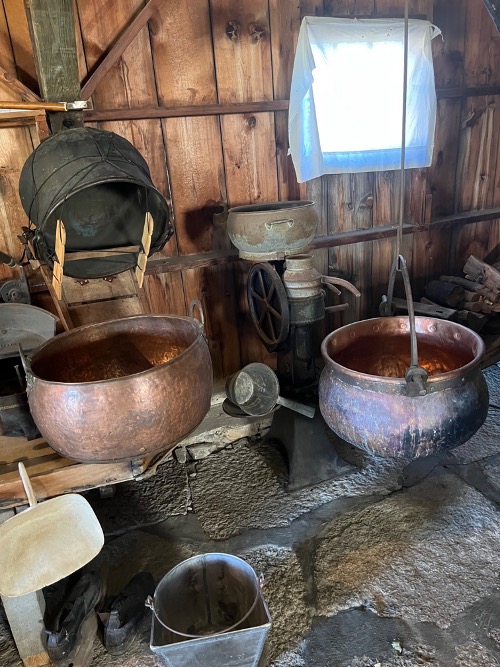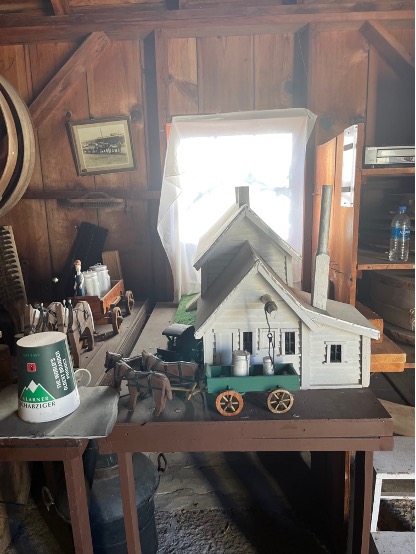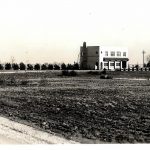Green County has long been known for its cheese factories, particularly ones making Swiss cheese. However, when the first Swiss immigrants arrived it wasn’t at all clear that they would go into cheesemaking at all. New Glarus’s rise to prominence as a cheesemaking town resulted from the development of its factories and the city’s increasing industrialization. Cheesemaking in New Glarus shifted from a domestic task that was done by members of the family to large cheese factories that could produce enough cheese to feed the nation.
At first, cheese was made in the home, primarily just for an individual family. Contrary to popular belief, most of the early colonists of New Glarus were not cheesemakers, but industrial artisans. They did not come to Wisconsin intending to be dairy farmers, until a few poor years of crop yields encouraged the community to look for alternatives to wheat. The limestone under the soil was also said to give the cheese a better taste because of the different minerals released. Until 1870, women primarily made cheese because it was considered a domestic task, while the men worked in the fields. Families primarily ate Schab-Zieger cheese, a type of cheese made from skim milk and particularly difficult to cure. Although there was some competition between families to make the tastiest cheese, there was no industrial market for cheese production and consumption. Homes might have had “cheese houses” for in-home cheesemaking, but because households utilized different methods of cheesemaking, there were no uniform standards for cheese production.
The first cheesemaker in Green County was Rudolph Benkert, who immigrated from Canton Bern in Switzerland and learned how to make Limburger cheese while in New York with his parents. He arrived in New Glarus in 1867 and started his own cheese factory. Nick Gerber founded the first cheese factory in New Glarus, making limburger cheese on a neighbor’s farm. He also started the first Swiss cheese factory in Green County in 1869. Gerber later ran six to eight cheese factories, buying milk from the farms around him. Although experienced makers were brought in from Switzerland to teach the colonists, young men also played an important role in cheese factories by working their way up and gaining experience as they went. Although women in New Glarus had primarily been involved in cheesemaking when it was an activity taking place in the home, young men were the ones who were able to rise through the ranks when the process became commercialized. This discrepancy highlights the divide in gender expectations for men and women during this time While men were able to participate in the business world, women were expected to stay at home and look after their families or participate in domestic work to bring in extra money.

Once these young men were older, they could-and often did-start their own cheese factories. Other important establishers of cheese factories were Jacob Karlen, John Boss, and Jacob Regez (also from Bern), who had connections across the country and the means and experience to find machines and cheesemakers. Most of the cheesemakers and their tools and supplies came from Switzerland, as connections between the two countries were still very strong at this time and Switzerland wanted the new colony to succeed. By the early 1880s, New Glarus boasted eighteen cheese factories.

Farmers were encouraged to sell milk to the cheese factories but were unsure about the factory’s chances of success at first because of the difficulty of making Swiss cheese. Cheese dealers emerged to help sell the cheese to the wider community, but it took a while for the market to stabilize. Early cheese factories still remained, on some level, a family affair. Families often lived in one part of the cheese factory while the cheese itself was made in another section. However, as the factories became larger and more industrialized, they became solely for cheesemaking. By 1883 there were 75 cheese factories in Green County, by 1911 there were 182 factories, and by 1925 Green County was making most of the country’s limburger cheese (which wasn’t as popular because of its smell) and a third of the Swiss cheese made in the entire United States. The growing number of factories encouraged the introduction of standards for the cheese produced, so all the cheese exported from Green County would be equally delicious.Although some discrepancies remained between supply and demand, as time went by, the industry became more and more profitable and Green County’s Swiss cheese became more and more well known across the world.
This notoriety and profitability would eventually alter the former colony’s relationship with Switzerland. Although Swiss immigrants had helped build the cheesemaking industry in the area, after Green County’s cheese became successful they were met with criticism in Switzerland for trying to ‘replicate’ Swiss cheese. In 1927, the Swiss Cheese Association of Berne started a campaign to make sure that Swiss cheese was only made in Switzerland because it had a “mountain flavor” that couldn’t be replicated in Green County’s flatlands. Switzerland’s cheese was advertised in publications like the Saturday Evening Post, Good Housekeeping, Vogue, Vanity Fair, and House and Gardens and the campaign was so successful that it caused prices to drop in Green County, and the foreign cheese became real competition to the Wisconsin cheese. President Calvin Coolidge, who was fond of Swiss cheese, eventually raised the tariff on foreign cheese, and to show their gratitude, Wisconsin cheesemakers visited him in the summer of 1928 with a 147 pound wheel of Green County Swiss Cheese.
Cheesemaking in Green County changed over a relatively short period of time from a family pastime to a world renowned industry that challenged Switzerland itself. Early cheesemakers took the challenge of responding to disappointing wheat yields and used it to create an industry that would bring prosperity and worldwide recognition to Green County. Although early cheese factories were relatively simple, they increased in capacity and complexity until the industry was successful enough to rival Switzerland, making a few families that controlled multiple factories very wealthy in the process. The growth of the cheese industry and the subsequent competition from Switzerland also highlights how the ties between Switzerland and the United States weakened as the colonists to the United States became more comfortable and prosperous in their new homes and no longer had to rely on their home country for support.
Written by Sophia Halverson, April 2023.
SOURCES
Luchsinger, John. The History of a Great Industry. Washington DC: Library of Congress, 1899
Odell, Emery A. Swiss Cheese Industry. Monroe, Wisconsin: Monroe Evening Times, 1936
Trewartha, Glenn Thomas. “The Dairy Industry of Wisconsin as a Geographic Adjustment”, PHD diss (University of Wisconsin, 1924)




